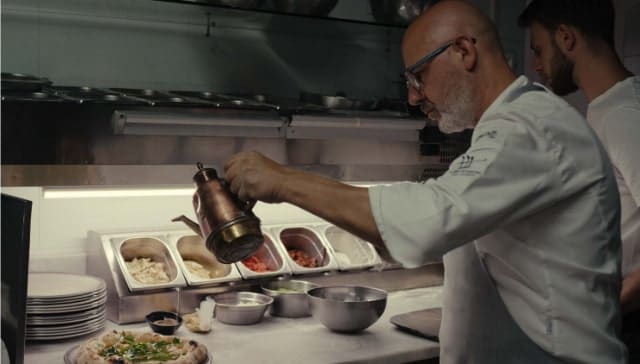Chef‘s Table: Pizza, created by David Gelb, is the most mouth-watering documentary series I have ever watched. Streaming on Netflix, it looks at how the much-loved pizza is not just fast food but an art form. Chefs bring their own traditions, recipes, personalities, and stories into it. The series features six of them – Gabriele Bonci, Ann Kim, Chris Bianco, Yoshihiro Imai, Franco Pepe, and Sarah Minnick. Their creativity is not limited to the toppings they use; it is about getting the right flour, making sauce from scratch, using good quality ingredients, and cooking at the most suitable temperature so that flavours, textures and aromas stand out.
Five different directors have worked on this six-episode series. Abigail Fuller, Clay Jeter, Zia Mandviwalla and Danny O’Malley have directed an episode each. Brian McGinn has directed two episodes. All these six episodes come together to form a harmonious whole. They capture all the toil and sweat that go into creating pizzas that are loved and relished.
While this series is about food, it is not something that you would want to binge on. It is worth relishing slowly, an episode at a time without any haste, because each episode has a strong emotional core. It is not easy to make a quick mental shift from one story to another. The documentary series explores why and how pizza became so central to the lives of these chefs, and also digs into their relationships with their families and communities. Most importantly, the series gives these chefs an opportunity to talk about their innermost feelings.
Chris Bianco, the chef who got famous with Pizzeria Bianco in Phoenix, Arizona, talks about how his childhood asthma made him spend considerable time indoors and became a blessing in disguise since he got to learn cooking from his mother and grandmother. Watch this series to know what makes him “the Yoda of the pizza oven” and why reputed food critics believe that his pizza is the best not only in the United States of America but in the whole world.
Bonci, who runs Pizzarium Bonci in Rome, Italy, sees himself as not just a pizza chef. He says, “I do agriculture. In every bite of my pizza, there are square metres of farm land.” This man cares deeply about sourcing his produce from small farmers, and building relationships with them. He is of the opinion that consumption should be an ethical and thoughtful activity.
“Pizza is one of those things that brings people together,” says Kim, who runs Pizzeria Lola in Minneapolis, USA. She believes in the power of food to help people rise above differences when they share a meal. As a person of Korean heritage in the United States, she delights in expressing her cultural identity through her cooking. She makes kimchi-inspired pizzas that honour the tastes and smells of her mother and grandmother’s traditional recipes that she was once terribly ashamed of because her school lunch marked her out as different from others.
Imai, who runs a restaurant called Monk in Kyoto, Japan, opens up about being addicted to baking bread while he was in college. He found that whenever he was baking, he was free of worries. When he told his parents that he wanted to pursue this interest professionally, they were upset with him. Eventually, they came around when they saw how hard he worked.
Franco Pepe, who runs Pepe in Grani in Caiazzo, Italy, talks about how the death of his father shaped his personal trajectory with pizza. He and his brothers inherited a pizzeria when the patriarch passed away. While his brothers wanted to continue replicating what their father made, Pepe wanted to innovate. The conflict became ugly, and he started his own pizzeria. Watch the episode to find out how the broken ties were repaired slowly and lovingly.
“People feel like there are actual limits on pizza. Pizza is an expression of a pizza maker. Everyone should explore that for themselves,” says Minnick, who runs Lovely’s Fifty Fifty. It is a pizza and ice cream place in Portland, Oregon – a part of USA that is not as well known for pizza as New York City. Minnick wants to change perceptions. She says, “I would be extremely bored making the same pizza every day.” Her desire to experiment has made her create pizzas that use flowers, peaches, grapes, amaranth and fenugreek as toppings.
If you are averse to trying out unusual pizza toppings, wait till you see what other chefs do on this show. They use pistachios, taro root, venison, blue potatoes, trout, foie gras, and salted mackerel. All the chefs are acutely conscious of their individuality and their idiosyncrasies. Some of their choices are connected to childhood memories, some are based on whims; others are based on what is available in the market, the garden, the forest or the hills.
The biggest strength of this series is its feel-good factor. It has gorgeous visuals of food being prepared, served and enjoyed in the company of loved ones. It has moving personal stories of people finding their calling, and making dreams come true despite the obstacles in their path. It has a good mix of insightful and entertaining interview snippets featuring food critics. It also shows how the act of cooking can be infused with so much love that the person offering the meal and the person receiving it are both fundamentally transformed by that interaction.
Chintan Girish Modi is a writer, journalist and educator who tweets @chintanwriting
Read all the Latest News, Trending News, Cricket News, Bollywood News, India News and Entertainment News here. Follow us on Facebook, Twitter and Instagram.

